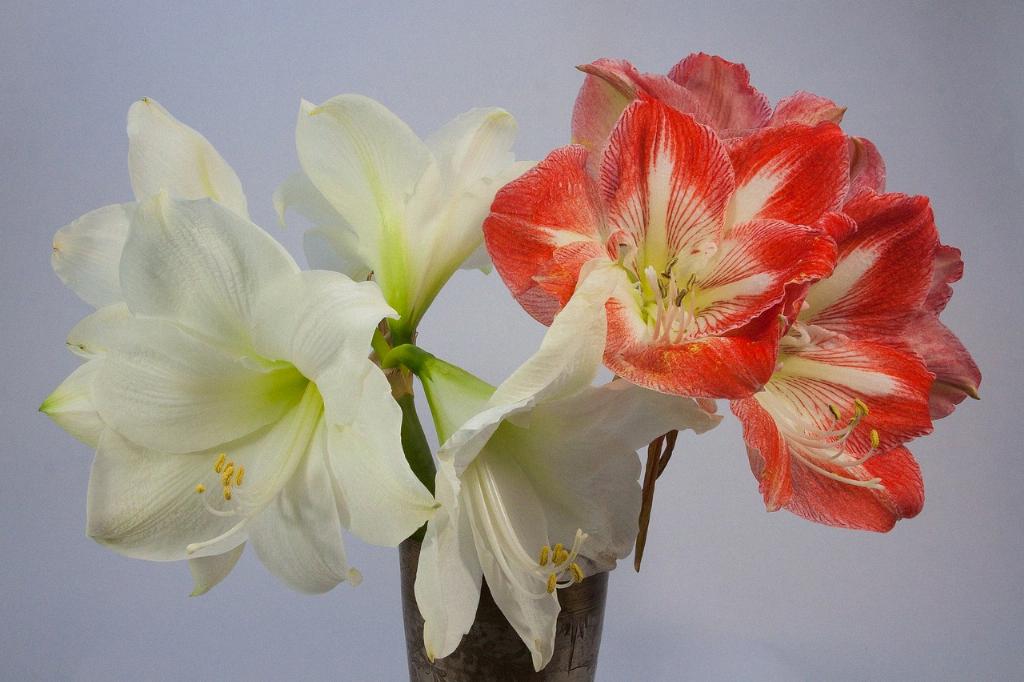Amaryllis plants, with their dazzling blooms and striking appearance, have captivated garden enthusiasts and indoor plant lovers alike. Known for their large, vibrant flowers, which range in color from the deepest reds to the most delicate whites and pinks, these plants can bring a touch of drama and color to any setting. Originating from tropical regions in South America, particularly from the Andes, amaryllis bulbs are typically grown indoors in colder climates, offering a splendid floral display in the winter months when most plants are dormant. They make an excellent center piece, especially during festive seasons, thanks to their bold and bright appearance.
Choosing the Right Amaryllis Variety for Your Home or Garden
Before you dive into the world of amaryllis, it’s crucial to choose the right variety that matches your aesthetic and environmental conditions. Amaryllis comes in several varieties, each with unique petal shapes, colors, and patterns. For instance, the ‘Red Lion’ is popular for its classic deep red blooms, while ‘Apple Blossom’ impresses with its soft pink flowers brushed with white. Pay attention to the maturity size and bloom time, which can vary widely between types. Consider the theme of your space or the garden setting where the amaryllis will live, as selecting a bloom color that complements your existing decor or garden palette can amplify the overall visual impact.
Essential Steps for Planting Amaryllis Bulbs
Planting amaryllis bulbs is straightforward but requires attention to detail to ensure successful growth and blooming. Start by selecting a pot that is approximately 1 to 2 inches wider than the diameter of the bulb, ensuring it has adequate drainage. Use well-draining soil mix, ideally prepared for bulbs, placing the bulb so that the top third remains above the soil level. This positioning encourages proper growth and blooming. Plant the bulbs around 6-8 weeks before you desire them to bloom, typically by early fall if you want a stunning Christmas display.
Best Practices for Watering and Feeding Your Amaryllis
Watering and feeding are pivotal in the care routine of your amaryllis. The soil should be kept moist but not waterlogged to prevent rot. Water the plant sparingly until you see about 2 inches of new growth, then increase watering to fully moisten the soil. As flowering progresses, reduce watering frequency to encourage the plant to enter dormancy. Feeding your amaryllis with a balanced liquid fertilizer every two to three weeks during the growing season will support its robust growth and vibrant blooming but stop feeding once the plant has flowered.
Sunlight and Temperature Needs: Ensuring Ideal Conditions
Amaryllis thrives in conditions that mimic their natural tropical habitat. Provide them with bright, indirect sunlight—around 4-6 hours a day. Direct sunlight can scorch the leaves, while too little light can lead to weak, floppy growth. Ideal temperatures for growing amaryllis range from 68-70°F during the day, slightly cooler at night, but avoid exposure to temperatures below 50°F. Such care ensures your plants remain healthy and are primed for the best floral show.
Pruning and Maintenance Tips for Amaryllis
Pruning is essential for the longevity and aesthetics of amaryllis plants. After blooms fade, cut off the flower stalk close to the base to prevent seed formation, which can sap needed energy from the bulb. However, leave the foliage in place as it helps in photosynthesis, feeding the bulb for the next growing season. Once all the leaves die back naturally, typically in early fall, cut them off to about 2 inches above the bulb, and store the bulb in a cool, dark place to rest before the next growing season.
Troubleshooting Common Amaryllis Problems and Pests
While amaryllis is relatively hardy, they can encounter issues such as bulb rot, leaf scorch, or pests like aphids and spider mites. Bulb rot often results from overwatering, so always ensure good drainage and careful watering practices. If pests are spotted, treat the plant with appropriate insecticidal soaps or neem oil, adhering closely to the directions on the label to prevent harm to the plant. With proper preventive care, including appropriate watering, feeding, and situating your amaryllis in ideal light conditions, most problems can be avoided.
Encouraging Your Amaryllis to Re-bloom
Getting your amaryllis to re-bloom year after year is truly satisfying and not overly complicated. After the blooming cycle, continue to water and feed the plant as the leaves are still active. As the season progresses and leaves begin to yellow, gradually reduce watering to encourage dormancy. Store the dormant bulb in a cool, dark place for at least 8-10 weeks. Then, reintroduce water and warmth to awaken the bulb for another season of splendid blooms. This cycle mimics the natural environmental triggers that amaryllis bulbs experience in their native habitats.
Fun Facts and Uses of Amaryllis in Decoration and Gifts
Amaryllis plants aren’t just admired for their spectacular flowers; they also hold a place of honor in holiday decorations and as thoughtful gifts. Their bold, dramatic blooms bring a lively splash of color to winter homes, making them popular Christmas gifts. A single amaryllis bulb can be a symbol of radiant beauty when given as a gift, representing the warmth and life-affirming qualities of the holiday season. The plant’s ability to bloom indoors during the colder months provides a delightful contrast to typically grey winter days, bringing cheer and color when it’s most needed.
Conclusion: Enjoying the Beauty of Amaryllis All Year Round
With the right care, amaryllis can be a long-lasting and repeatedly blooming plant that brightens your home or garden. By understanding the needs of your amaryllis, from the right soil and watering practices to the specific light requirements and rest periods, you can ensure these stunning plants provide spectacular blooms year after year. Whether adding a vibrant splash of color to your living space or giving a gift that grows, amaryllis stands out as a remarkable choice for both beginner and experienced gardeners alike. So why not give it a try and see how this magnificent plant can transform your gardening experience?

